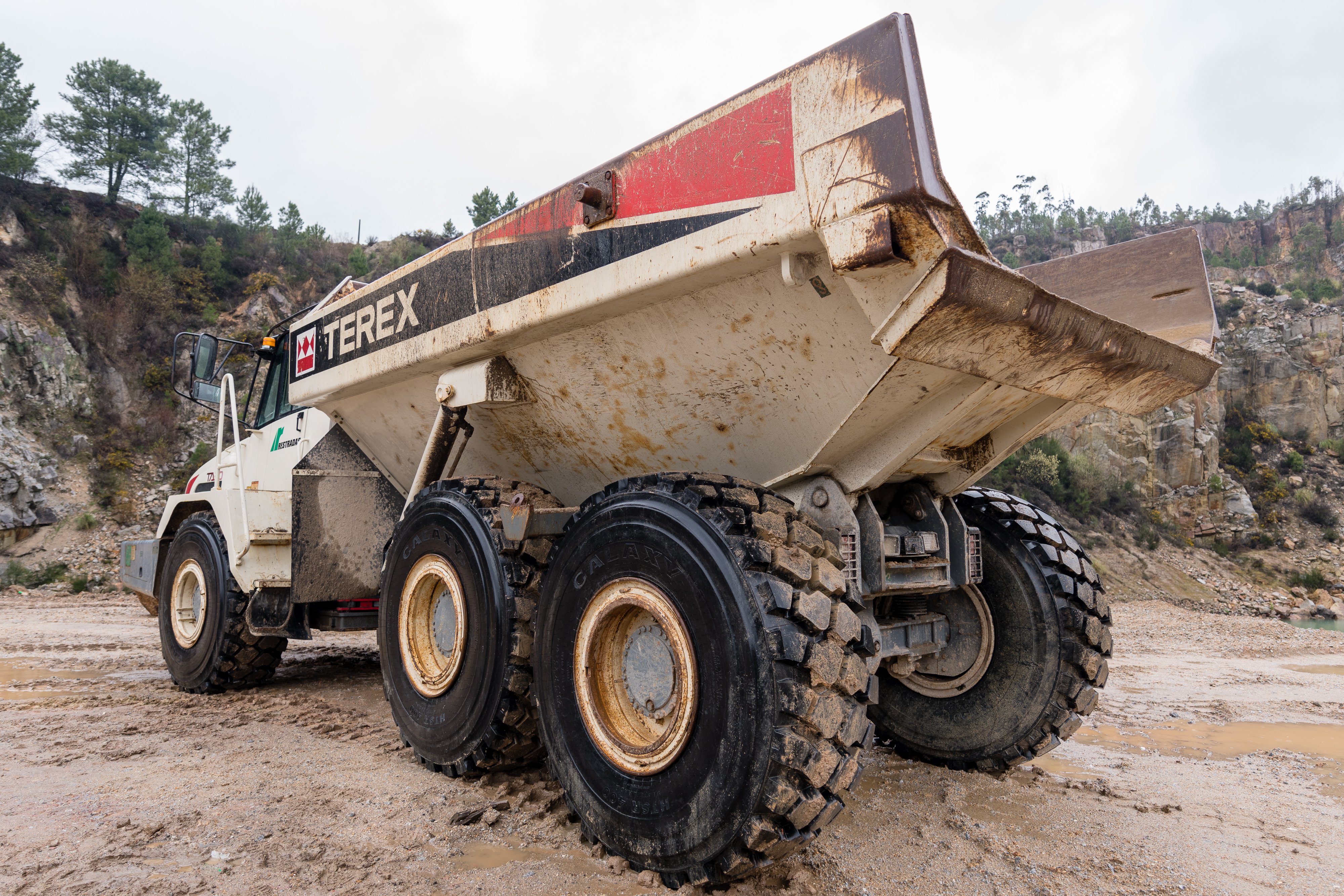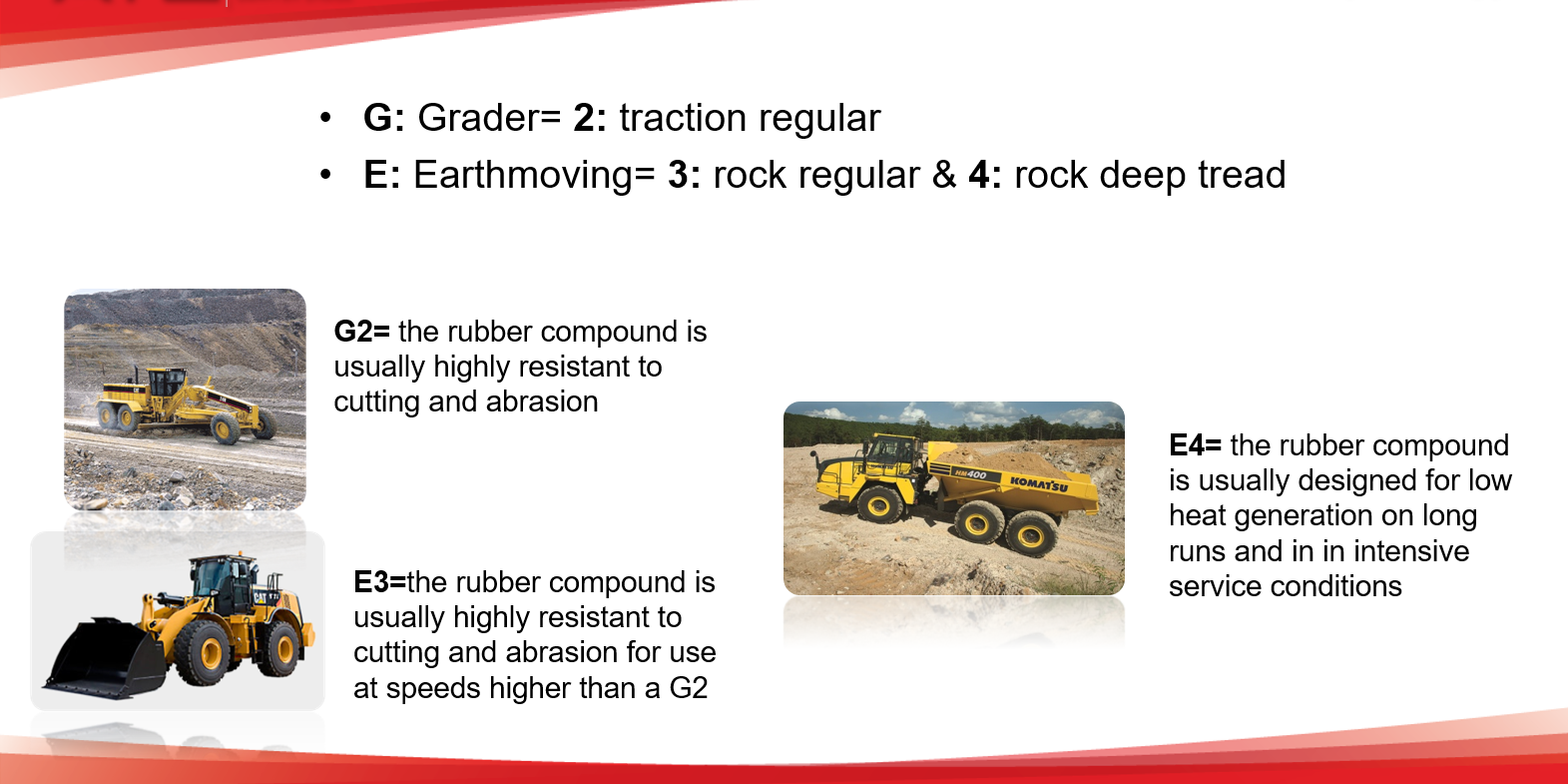Grader, Loader, and Earth Mover Tires
Today’s construction sites are home to a wide array of specialized machinery, with each piece of equipment designed to handle the unique challenges facing it. Similarly, the tires for specialized construction equipment are also engineered to stand up to the distinct demands placed on them—after all, a dump truck carrying heavy loads at high speeds has different needs than a grader traveling at slow speeds.
As construction equipment continues to grow larger, more powerful, and specialized, it is vital to match your machine with a tire suited to its application.

Machine Classifications
To ease the understanding of an OTR tire’s intended application, the Tire and Rim Association (TRA) has adopted a uniform classification system that is adhered to by all manufacturers.
G (Grader): Tires marked G are for use on motor graders and are rated to travel unlimited distances at speeds up to 25 mph. Used for grading and leveling surfaces on construction sites and road work, motor graders are also commonly employed in snow removal. Because of the tasks required of a G tire, they’re engineered for traction and directional stability.
L (Loaders): L-classified tires are intended for use on front-end loaders and dozers and are designed to travel short distances at low speeds—say, 250 feet at 5 mph. Since these types of machines are asked to do everything from push material to pick it up, L tires are designed to handle heavy loads and prioritize stability.
E (Earth Movers): Tires classified as E are for use on equipment such as rigid and articulated dump trucks, and scrapers. E tires are engineered to travel a maximum distance of 2.5 miles one way at a top speed of 30 mph. E tires are tasked with traveling moderate distances at relatively high speeds; consequently, they’re designed with load capacity, speed, and heat dissipation in mind.
Tread Depth and Compound Classification
Just as OTR tires use a letter to designate their intended machine, the TRA also assigns a number that is used to indicate tread depth and compound.
- 2: indicates a regular tread depth and compound designed to provide maximum traction
- 3: signifies a regular tread depth and a compound that’s engineered for extra resistance to scrapes and impacts
- 4: specifies tires with 1.5 to 2 times as much tread depth as a 2 or 3 tire and a compound that’s built for rock resistance
- 5: designates a tire with 2 to 3 times greater tread depth than a regular (2 or 3) tire with cut and abrasion resistance
Putting TRA Classifications Together
When combined, the TRA codes give a clear indication of a tire’s intended purpose. For example, an L-2 tire is ideal for general-purpose wheel loader applications, and an E-4 tire is best suited on a dump truck operating in rough, rocky, and intense terrain.

Dual-Marked Tires
It’s not uncommon to come across dual-marked tires. For example, an E-3 / L-3 tire—such as our Galaxy EXR 300—is capable of being used on either a transport vehicle or a loader vehicle. Similarly, a G-2 / L-2 tire—like our Galaxy Giraffe XLM—can be used on a motor grader or backhoe.
Note that these TRA classifications are not a marketing designation—they reflect important design, engineering, and manufacturing factors specific to the demands placed on tires used on different machines and circumstances. It is never recommended to use tires for applications outside of their marking categories.
Consider a Radial
Radial tires are becoming increasingly common on today’s construction sites. Using the same TRA classifications as their bias counterparts, radial tires offer a host of advantages in certain applications. For example, radials dissipate heat (the #1 enemy of tires) better than bias tires—a key consideration for earthmovers traveling long distances at higher speeds. In fact, radials generally last longer and provide a lower total cost of ownership than a comparable bias tire, especially on equipment that covers a lot of ground or operates at higher speeds.
Check out our blog Why Switch Compact Construction Equipment to Radial Tires? to learn more about the advantages radial tires can offer your construction business.
Application-Specific
To make the most out of your tire investment, it’s important to properly pair your tires to the work with which they’re tasked. After all, there’s no point in putting an aggressively treaded tire designed for maximum traction on a machine that will spend the majority of its time working on hard, solid surfaces such as asphalt or concrete. Likewise, you don’t want to select a tire built to work on improved surfaces if it will primarily be used on uneven terrain and in the mud.
Check in with your local dealer or rep to learn more about our robust line of grader, loader, and earth-mover tires, and how advancing tire technology can help improve the efficiency and profits of your construction company.
If you’re unsure what tire is best suited to your machine, your local dealer or rep can help. Contact them today!

